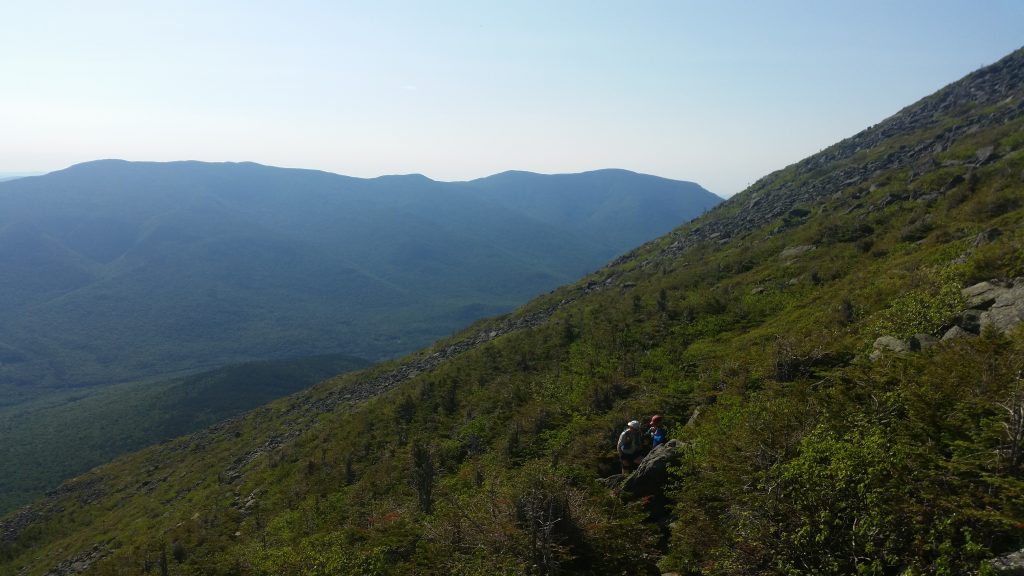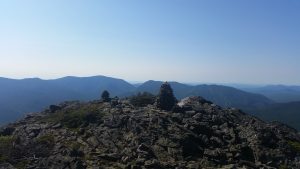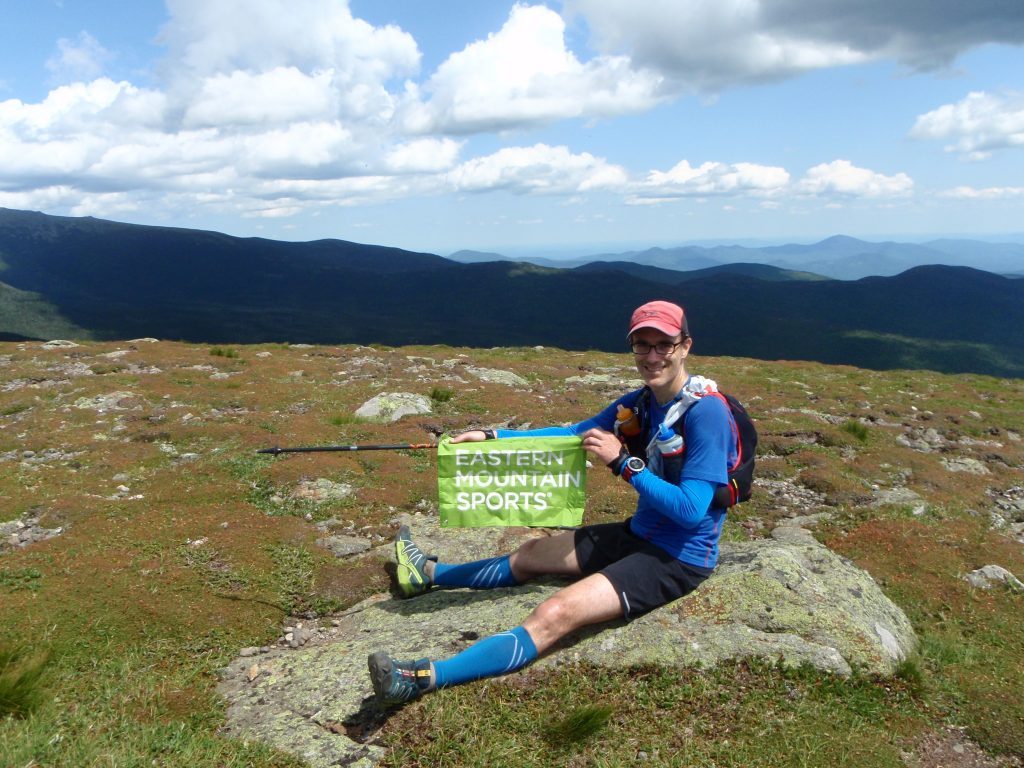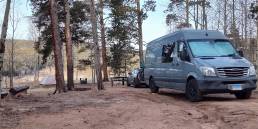At some point on Wednesday, June 26th, I regain enough awareness to recognize I am in a hospital bed, talking to a woman with long brown hair. But, her face is strangely elongated—elongated in a Hollywood scary movie kind of way and shaped like an inverted pear. Whatever. She tells me I am in the Special Care Unit (SCU) of Maine Medical Center in Portland, Maine. I ask her if I have been given narcotics, and the answer is yes. That explains some of my confusion. I ask for her name, and the answer is Kathy. I say, “That’s spooky. My wife’s name is Kathy.” She laughs. I pass out.
During my fleeting but slowly lengthening moments of lucidity, the SCU nurse in charge of my care helps Kathy explain that after completing the 23-mile Presidential Traverse run across the White Mountains, I was taken to the hospital. I had become combative, and my friends drove me to the ER. I am immediately very embarrassed. Did I do something mean? Did I hurt anybody? They tell me, “No, it was nothing like that.” Then, they say something about an infection, tests, and not knowing exactly what happened. Thus begin my questions.
Do I know my name? Yes.
Do I know where I am? Yes, Maine Med in Portland, Maine, as she just told me.
Where do I live? “Portland” draws a wrinkled brow, since I’m in Portland, Maine, but live in Portland, Connecticut. It’s hard for me to explain, but fortunately they’re not high on narcotics and quickly grasp the coincidence.
Do I know what year it is? I look at the wall calendar. 2016.
Do I know what day it is? Next to the calendar is a whiteboard on which the team has written the day and date. I read it aloud.
Do I know why I’m here? Not really. Some kind of combativeness infection or something.
Do I have any bug bites? Did I eat anything unusual recently? Have I had any rashes? Spider bites? International travel to Ebola or Zika territory? Ticks? Illness of any type? Cuts or surgeries? Prescription drugs? Alcohol? Non-prescription drugs? I answer these questions multiple times to different people. The answer is always “No” to everything, except for the two Advil halfway through the run.

Reading my charts afterward, I learn that a large contingent of medical professionals from North Conway Memorial Hospital (the ambulance service that transported me to Maine Med) and Maine Medical Center, including the head of neurology, had made every effort possible to ascertain exactly what caused the shift in my mental state after the run. They ran every test known to modern medicine to figure it out: MRI of the brain, head CT scan, spinal tap, X-rays, tick panel, tests for enterovirus, chicken pox, herpes, hepatitis, meningitis, complete metabolic panels, and more. Nothing definitive was revealed. In sum, they diagnosed me with “encephalopathy of unknown origins.” I looked it up: Encephalopathy is a big Latin word for “the brain’s broken.”
I had also experienced an electrolyte imbalance and dehydration, which some of my charts noted as severe. My treatment was a careful elevation of the blood sodium level, along with a complex dose of antivirals, antibacterials, and sedatives to keep me calm while my brain recovered, until I could come out of sedation without getting agitated—basically, a mini chemo treatment plus narcotics.
Wednesday night, I am stable enough to transfer from SCU to a room on the sixth floor. By then, I also determine that the face of the nice, brown-haired lady named Kathy has returned to normal. And, oh, by the way, she is actually my wife. On a side note, I am never going to live that one down: Even my 12-year-old pulls it out for laughs once in a while.
Thursday, I spend a good chunk napping between checks of my vital signs, heparin shots in the belly (the worst, as they feel like stings from an angry hornet), IV changes, and blood samples. My doctors come through periodically, still frustrated and mystified that they cannot determine what happened, and seemingly amazed by my rapid recovery. They even bring in the current batch of students to check out my curious case, all eager, fascinated, and amazed that someone would run so far in the mountains and find themselves inexplicably hospitalized. Kathy tells me this isn’t their first visit, and that, while I was sedated down in SCU, one of them had asked the chief resident leading them, “Look at his legs by the knees – what’s wrong with them?” The resident responded with, “Those are his muscles. We don’t often get people this fit in SCU.” I feel sympathy for zoo animals.
Thursday also includes appointments with other professionals: therapists of the physical and occupational persuasions. The physical therapist is Germanic, abrupt, and strong. She tells me we’re taking a walk, and off we go to do a fourteenth of a mile circuit around the unit. It’s tricky: She keeps a firm grip on my arm as I reacquaint myself with being upright and moving. I feel challenged and disoriented, but she reports nothing unusual, given my experience.
The occupational therapist, on the other hand, puts me through some enlightening paces. While I know who and where I am and what day it is, I cannot write my name. I know the letters but cannot command my hand to operate the pen properly. Uh-oh. We do some other exercises, one of which tests my word recall. I have two minutes to state as many words as possible that begin with the letter “F.” I struggle to say a few, coming up with “figment” and “fragment” and a couple others. Then, I say, “philanthropist.” The OT looks askance at Kathy, and they both roll their eyes. Yep, the brain’s still broken.
Later in the day, I meet with her again and show a bit of progress and, then Friday morning, realize more progress. By then, I can write my name almost normally, and I recognize patterns in words and pictures and can perform calculations and brainstorming operations with more efficiency and accuracy. I’m even reading a novel about Lance Armstrong from the wing’s lending library. Then, a speech therapist checks me out and, after another battery of tests, deems me on the road to recovery. They all tell me to take it easy and be patient, as it’s unclear exactly how much I will recover over time, even though in just a few days I’ve made significant strides.
I get one more test before the doctors agree to discharge me: an ultrasound of my abdomen, to investigate the source of pain in the upper right quadrant. I am frustrated by the delay: I want out of this joint. But, I stick it out. The test reveals a minor irritation with the wall of my gallbladder. I ask myself, “Do we still even use our gallbladder?” The doctor says it should resolve itself over time.
Late Friday afternoon, I am discharged, with paperwork stating my intake reason was sudden onset confusion and the blood and cerebrospinal fluid tests performed indicated no infectious causes. Instead, I had an electrolyte disturbance known as hyponatremia that resulted from severe dehydration related to my hiking activities. To follow up, I have an appointment set with my primary care physician and a prescription for blood work. Finally, I get to head home, and Kathy and I thank the staff on our way out.
Over the ensuing weeks, I seek explanations. I ask Mark, Sean, and Nat, my partners on the run, and Kathy what happened, and request copies of my charts from both hospitals. Then, I work on rebuilding the narrative, to assemble in my own mind a clear understanding. My brain injury hinders my effort, as I have to reprocess things multiple times before they sink in.
Here’s what I learn about how events unfolded. After running and hiking 20-or-so miles, my feet fell asleep but reawakened after I removed the compression calf sleeves, and I vomited all the water and food that was in my gut. I walked with Mark back to Mizpah Spring Hut, where we met up with Nat and Sean. We refilled our water for the last time, had some snacks, and collected ourselves. I snuck off the trail to vomit again, and then, we ran the three miles down to the car. I had regained my bearings enough to cruise that section, in fact running at a pace too quick for Mark’s comfort, as he was fatigued. Near the parking lot is a small dunking pool, and the guys cooled off there, effectively icing their calf and thigh muscles in the mountain stream. While the guys splashed in the pool, I sat quietly by the side and ambled away to vomit one last time.

By this point, I was still coherent but quiet, giving the impression I was just bonking pretty hard, or having very low energy due to the day’s intense activity. When we got to the car, I laid down exhausted on the pavement. After a bit, the guys encouraged me into the passenger seat and headed for the nearest convenience store, thinking some Coke and potato chips would introduce the sugar and salt my body needed to generate some more energy. When, after a few minutes, I grabbed the steering wheel and mumbled incoherently, they realized I needed more than junk food.
From there, they took me to the hospital in North Conway, arriving at 8 p.m. But, as I didn’t want to get out of the car and was not communicating verbally, it took four people to get me into a wheelchair. Once in the ER, I was still agitated, uncommunicative, and resistant to the care they tried to administer with IVs and other equipment. The staff determined for my safety and theirs that restraints and sedation were needed.
They also gave me three liters of normal saline in one-liter boluses over three hours. Every time the sedation started to wear off, I fought the restraints and tried to remove the IVs and electrodes. When Mark explained this to me, he said, “It was clear you did not understand what was going on, and you were fighting for your life.” The hospital staff realized I needed a higher level of care than they could provide, and at 1:00 a.m., they transferred me to Maine Medical Center via ambulance.
At Maine Med, I continued to receive excellent care. The Special Care Unit doctors were convinced, based on their experience and research, that my behavior indicated a viral infection, but tests failed to pinpoint a known virus. So, as they treated me for low blood sodium, they also gave me the shotgun doses of antivirals and antibacterials to treat all kinds of nasty stuff.
After my discharge and a couple days of recovery at home, I research hyponatremia in endurance athletes. I learn that this condition is almost always a result of water intoxication, or over-hydration. So, thinking back, I carefully review how much water I consumed, confirm I kept at or below my target rate of 20 to 25 ounces per hour, and do not believe I over-hydrated myself during the run. I conclude I was probably mildly to moderately dehydrated, the opposite of over-hydrated. More confusion.
Unlike on past runs, I did not take electrolyte supplements or drinks, because I knew the food we made contained much of what the supplements provide. I wonder if not taking them caused my sodium level to get too low. Normal blood sodium levels are between 133 and 145 mEq/L, and my first test done in Maine Med at 6 a.m. on Sunday showed a level of 126, which then dropped to 124 by 8 a.m. My research also reveals that a coma commonly occurs at 120. The gratitude I have for my running partners increases exponentially, as I realize they saved my life by getting me to the hospital when they did.
Unsatisfied with my diagnoses from the hospital, I wonder if talking with someone experienced in helping endurance athletes is an option. Internet searches for experts in Connecticut yield one really good candidate: a UConn professor who runs the Human Performance Laboratory and has published scholarly studies on hyponatremia, dehydration among soldiers, and more subjects. I email him, asking if he’d be willing to review and discuss my experience. I also try a sports medicine doctor, but his specialty lies in things like twisted ankles and rotator cuff tears. After two weeks of obsessive research and questioning, I get lucky and receive an email from the UConn guy. He is willing to review my case and share his insights!
The professor organizes a conference call that includes him, me, and two of his colleagues who are experts in human hydration and exertional heat exhaustion. They ask for even more details than I have, like urine output and sweat rate – gross. But, that, plus the information from the other doctors, is what it takes to understand the situation and the likelihood of it happening again. After a couple calls, I develop the final picture of what occurred.
A virus infected my gut, compromising my body’s ability to process the food and water I consumed on the run. After 20 miles, when my gut started signaling that it needed to be emptied, my brain shunted the blood flow away from my extremities to protect my core, causing my feet to fall asleep. Then, I vomited. Because I did not absorb any nutrients, including sodium, from the food, and as I had run 20 miles on a beautiful, sweaty day in the mountains, my blood sodium level dropped. The lack of sodium changed the chemistry within my cells, compromising my brain’s signals, and also increased the volume of intracellular fluid, causing my brain to swell and pressure to build up in the skull, resulting in cerebral edema. The electrolyte imbalance then injured my kidneys and liver. The antivirals and antibacterials were so strong they may have also compromised my organs a bit. Because the virus was unidentifiable, however, it is highly unlikely to happen again.


Exercise-associated hyponatremia (EAH) is a complicated condition which is difficult to diagnose or treat, and even experts like the folks at the UConn Human Performance Lab need to conduct further research on some of the contributing factors. It’s also not widely encountered or understood within the traditional medical community. After all, how many folks run super long distances or difficult terrain for entire days and then go to the ER? Among those who do, their individual factors vary widely, presenting opportunity for conflict and controversy. Diagnosis is then compounded by a delayed onset of symptoms in many cases. Treatment depends on whether the patient’s total fluid volume is too high or low and whether their symptoms are mild or severe.
My encephalopathy and measured sodium levels placed me squarely in the severe category. Recommended treatment of severe EAH with encephalopathy (EAHE) is a 100mL bolus of three-percent saline, possibly repeated until improvement is shown. But in a typical ER, this is a very risky treatment, so, unless the staff is familiar with the nuances of accurately diagnosing and treating severe EAH, it’s unlikely to be used.
Normal saline is not recommended for severe AEHE in folks with high-fluid volumes, as it does not increase blood sodium fast enough relative to the volume. Mild EAH, on the other hand, can be treated by simply drinking four bouillon cubes in a half cup of water!
I don’t know if I had high- or low-fluid volume. Whether or not I received the perfect treatment protocol is irrelevant to me. My friends, the hospital, and ambulance teams kept me alive, and thanks to them, I get to continue being a husband, father, worker, and mountain runner.
Regardless of the etiology and symptomatology of EAH, if I am going to keep doing things like run the Presidential Range, I need to prevent it. The primary cause of EAH is over-hydration; prevention involves drinking to thirst, instead of following some arcane rule, like “more is better.” I have measured my sweat rate by weighing myself before and after an hour-long run, during which I drank nothing. That weight difference, in ounces or milliliters, is how much fluid I need to replace per hour on long runs – nothing more. If it’s particularly hot, I can increase it a little, but still only drink to thirst. The jury’s still out on whether electrolyte supplements curb the risk of EAH, but taking them has never hurt me in the past, so I will continue using them.
Three months after that fateful Presidential Traverse, I am back to my normal summer and fall level of mountain biking and trail running, and working. I still have some short-term memory and word recall issues, but honestly, that may be just old age.
On October 7th, three days after I submitted this article, I started the longest race I have ever attempted, one which has a 48-hour cutoff time and a whole lot of climbing in Washington’s North Cascades Mountains. When this article was published, I had not yet returned from the race. But, I went into it knowing I never train well, and as this summer’s training blew up in June, I knew I had little chance of completing the course. I started because I can, because I have a running partner who has agreed to stay with me, and because I love being in the hills with friends. And, I can’t wait to go back for another run across the Presidentials next summer!

Brook Burke
Brook is an aging multisport athlete whom multiple doctors have reminded is no longer 18 years old. He skis, paddles, rides, climbs and runs with some frequency throughout the woods and waters of New England and occasionally further afield. Since 2007 he’s been an employee at EMS Corporate Headquarters, where he helps run the ems.com website while plotting his next batch of adventures. His favorite trips include backcountry telemark skiing in Quebec, rock climbing in Huntington Ravine, running around Mount Hood, self support kayaking through the Grand Canyon, sea kayaking the Maine Island Trail, and pedaling the Hampshire 100 mtb race. He enjoys helping people learn to be independent outdoors, and his motto is ‘recover gracefully’, mainly because he wipes out a lot.
Related Posts
1 Comment
Comments are closed.





wow…what a great story. I’m thankful you are ok and I’m thankful you had good friends and doctors to take care of you. I hope your wife and kids aren’t too hard on you for the Kathy thing. Cheers!